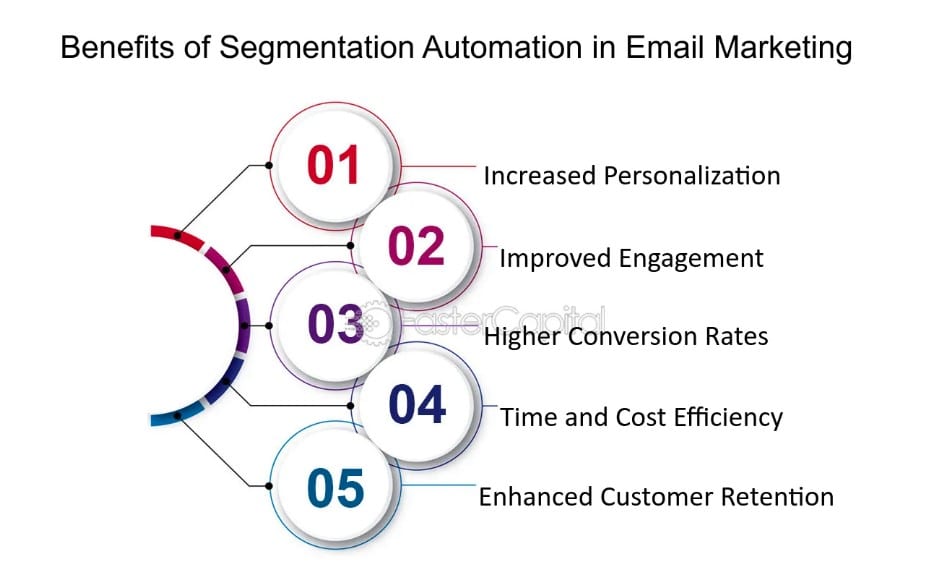Email marketing has become one of the most effective and efficient ways for businesses to engage with their audience and drive conversions. However, to truly master your email marketing game, it is crucial to understand and harness the power of key metrics. By analyzing these metrics, you can gain valuable insights into the performance of your campaigns and make data-driven decisions to optimize your email marketing strategy. In this blog, we will unveil the key metrics for email marketing success and provide practical tips on how to leverage their power to achieve your business goals. So, let’s dive in and take your email marketing to the next level!

The importance of email marketing in today’s digital landscape
In today’s digital landscape, where consumers are constantly bombarded with ads and promotional messages, email marketing has emerged as a powerful tool for businesses to cut through the clutter and connect with their audience on a more personal level. Unlike traditional forms of advertising, email marketing allows businesses to directly reach out to their subscribers’ inboxes, giving them a prime opportunity to deliver relevant and targeted content.
Not only does email marketing offer a higher return on investment compared to other marketing channels, but it also helps build trust and loyalty with your audience. By consistently delivering valuable and engaging content to your subscribers, you can cultivate a positive relationship with them, increasing the likelihood of conversions and repeat customers.
Furthermore, with the help of key metrics, you can track and measure the effectiveness of your email marketing campaigns. These metrics allow you to determine the open rates, click-through rates, and conversions generated from your emails, enabling you to make data-driven decisions and optimize your strategy for better results.
In the next section, we will delve into the specific key metrics that you need to pay attention to and provide actionable tips on how to harness their power to achieve email marketing success. So, stay tuned and get ready to take your email marketing game to new heights!
Understanding the key metrics for email marketing success
To achieve email marketing success, it is crucial to understand and track key metrics that determine the effectiveness of your campaigns. By analyzing these metrics, you can gain valuable insights on how your emails are performing and make informed decisions to improve your strategy. Let’s dive into the specific marketing key metrics you need to pay attention to:
- Open rates: This metric measures the percentage of recipients who open your emails. A high open rate indicates that your subject lines and email preview are compelling enough to capture the attention of your subscribers.
- Click-through rates: This metric tracks the percentage of recipients who click on the links within your emails. It shows the engagement level of your audience and how well your content entices them to take action.
- Conversion rates: The conversion rate measures the percentage of recipients who complete a desired action, such as making a purchase or filling out a form. This metric indicates the effectiveness of your calls-to-action and the overall impact of your emails on driving desired outcomes.
In the following section, we will provide actionable tips on how to harness the power of these metrics to optimize your email marketing strategy and achieve better results. Stay tuned for valuable insights that will take your email marketing game to new heights!
Tracking opens and click-through rates for effective email campaigns
To maximize the effectiveness of your email campaigns, it is essential to track both open rates and click-through rates. These metrics provide valuable insights into the engagement level of your audience and the overall performance of your emails.
Open rates indicate the percentage of recipients who actually open your emails. A high open rate suggests that your subject lines and email previews are compelling and enticing enough to capture the attention of your subscribers. To improve your open rates, consider personalizing your subject lines, keeping them concise and impactful, andA/B testing different variations to see what resonates best with your audience.

Click-through rates, on the other hand, measure the percentage of recipients who click on a link within your email. This metric is important because it shows how effective your email content and call-to-action are in driving engagement and conversions. To improve your click-through rates, make sure your emails have clear and prominent calls to action, use engaging and relevant content, and optimize your email design for easy navigation and readability.
Tracking both open rates and click-through rates allows you to identify which emails are performing well and which ones may need improvement. By analyzing these metrics, you can gain insights into your audience’s preferences and behavior, and make data-driven decisions to optimize your email campaigns.
In addition to open rates and click-through rates, other email metrics to track include bounce rates (which indicate the percentage of emails that are undeliverable), conversion rates (which measure the percentage of recipients who take a desired action after clicking through), and unsubscribe rates (which show how many recipients are opting out of your emails). By monitoring these metrics, you can identify any issues or areas for improvement in your email campaigns, and take steps to address them.
By closely monitoring and analyzing these key metrics, you can identify patterns, understand what works best for your audience, and make data-driven decisions to optimize your email marketing strategy. In the next section, we will delve deeper into conversion rates and how they play a crucial role in measuring the success of your email campaigns. Stay tuned for practical tips on how to improve your conversion rates, manage your campaigns effectively and drive the desired outcomes from your email marketing efforts.
Harnessing the power of conversion and ROI metrics
In the world of email marketing, it’s not just about getting your subscribers to open your emails and click on links – the ultimate goal is to convert those actions into tangible results. Conversion rates and Return on Investment (ROI) metrics are essential indicators of the success of your email campaigns and the impact they are having on your business.
Conversion rates measure the percentage of subscribers who take the desired action, such as making a purchase, filling out a form, or signing up for a webinar, after clicking on a link in your email. A high conversion rate indicates that your email content and call-to-action are effective in driving the desired outcomes. To improve conversion rates, consider optimizing your landing pages, simplifying the checkout process, offering incentives or discounts, and providing clear and compelling messaging that aligns with your email content.

ROI metrics, on the other hand, measure the financial return on your email marketing investments. It helps you understand the revenue generated compared to the costs incurred, enabling you to assess the overall profitability of your email campaigns. To calculate ROI, subtract the costs associated with your email marketing efforts from the revenue generated from those campaigns, and divide the result by the costs. A positive ROI indicates that your email marketing strategy is generating a return and contributing to the bottom line of your business.
By tracking and analyzing these conversion and ROI metrics, you can gain valuable insights into the effectiveness of your email campaigns and make data-driven decisions to optimize your strategies. In the next section, we will explore the importance of list growth and engagement metrics in building a strong and responsive email subscriber base. Stay tuned for practical tips on how to grow your list and nurture meaningful relationships with your subscribers.
A/B testing and optimizing your email marketing strategy
A/B testing is a powerful tool that allows you to experiment with different elements of your email marketing strategy to determine what works best for your audience. By creating two versions of an email and sending them to different segments of your subscriber list, you can compare the performance of each version and identify the most successful approach.
When conducting A/B tests, focus on one element at a time, such as the subject line, call-to-action, or design. This way, you can isolate the impact of each variation and make informed decisions based on the results.
To optimize your email marketing strategy, analyze the data from your A/B tests and make adjustments accordingly. Use the insights gained to fine-tune your subject lines, create more engaging content, enhance the design, or personalize your emails. Continuously testing and optimizing your approach will help you maximize your email marketing ROI and achieve better results over time.
We will dive into the realm of email deliverability and the importance of ensuring that your emails reach your subscribers’ inboxes. Stay tuned for expert tips on improving your deliverability rates and avoiding the dreaded spam folder.
Utilizing automation and segmentation to maximize results
Automation and segmentation are two vital components that can take your email marketing game to the next level. By utilizing automation tools, you can streamline your email campaigns and ensure timely delivery of your messages to your subscribers.
Segmentation, on the other hand, allows you to divide your subscriber list into smaller groups based on specific criteria such as demographics, purchase history, or engagement level. This enables you to send personalized and targeted emails to different segments, increasing the chances of conversion and engagement.

When implementing automation and segmentation, start by identifying the key touchpoints in your customer journey. Map out the different stages and create automated email workflows that cater to each stage, delivering relevant content at the right time. For this, you can use various email marketing tools, such as email sequence software or others.
Segmentation, on the other hand, allows you to divide your subscriber list into smaller groups based on specific criteria such as demographics, purchase history, or engagement level. This enables you to send personalized and targeted emails to different segments, increasing the chances of conversion and engagement.
Furthermore, leverage segmentation to understand your audience better and tailor your messages accordingly. By creating segments based on different customer profiles or interests, you can send highly targeted emails that resonate with each segment.
We will discuss the power of personalization in email marketing and how it can significantly impact your campaign’s success. Stay tuned for expert tips on effectively personalizing your emails to forge stronger connections with your audience.
Taking your email marketing game to the next level
Personalization is the key to taking your email marketing game to the next level. By tailoring your messages to individual subscribers, you can create a more personalized and engaging experience that resonates with your audience.
One effective way to achieve personalization is by using dynamic content in your emails. Dynamic content allows you to display different elements based on certain conditions or customer data. For example, you can showcase personalized product recommendations based on a customer’s past purchases or display different images depending on the customer’s location. You can also use remove object from photo tools to ensure the images are perfectly tailored to each recipient.
Another strategy to enhance personalization is by utilizing behavioral data. By tracking how subscribers interact with your emails and website, you can gain valuable insights into their preferences and interests. Use this data to send targeted emails that align with their behaviors, such as abandoned cart reminders or tailored recommendations. Additionally, adding social proof in your emails using top social proof apps can further build trust and credibility with your audience.
As Keran Smith, Co-Founder and CMO of LYFE Marketing, states, “Remember, personalization goes beyond simply addressing subscribers by their first name. It’s about creating a tailored experience that makes them feel valued and understood. In the next section, we’ll dive deeper into the tactics and tools you can use to personalize your email marketing campaigns effectively. Stay tuned for more.
Conclusion
In conclusion, mastering the art of email marketing requires understanding and leveraging key metrics for success. By implementing personalization techniques, such as using dynamic content and utilizing behavioral data, you can create a tailored experience for your subscribers that resonates with their preferences and interests.
The power of data-driven email marketing strategies cannot be underestimated. By analyzing the data collected from your email campaigns, you can gain valuable insights into your audience’s behavior, preferences, and engagement levels. This information allows you to make informed decisions and optimize your email marketing efforts for better results.



